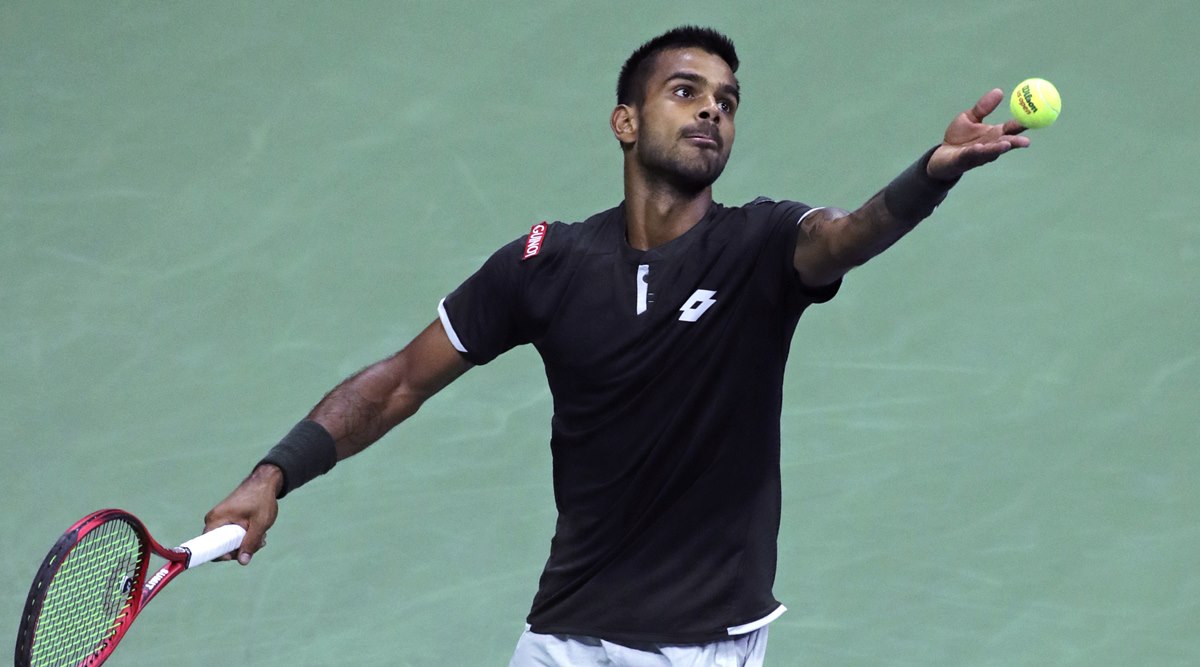Sumit Nagal, who will debut in the main draw of the Australian Open this year, goes on to describe how they are required to sanitise their hands after every 50 metres at the practice venue.
There’s a groan on the other side. It’s an involuntary reaction by Sumit Nagal, followed by an explanation about what his hotel room in Melbourne looks like in the absence of housekeeping services.
“It looks nothing close to what it was when I first walked in. I’ll really feel bad for (hotel staff) when I leave,” he offers. “And every time I come back and look at the room, I’m like, ‘my God…’”
The important thing here for Nagal, however, is that he can indeed leave his room, for five hours a day.
As the top players on the tennis circuit descended upon Melbourne ahead of the Australian Open, one of the arrangements made in this COVID-19-stricken era was that they were allowed to leave their rooms to train and practise for five hours in a day, during the mandatory 14-day quarantine. Three of the 15 chartered flights that carried the players to Australia, however, had people testing positive on arrival, meaning all the 72 players on those planes were forced into hard quarantine.
Nagal wasn’t one of them. But the five-hour spell he gets outside has been nothing like he’s ever experienced before. The months spent in planning by Tennis Australia, in consultation with the Victoria government, has led to a strict series of protocols when it comes to players leaving their rooms for training. And it all has to be followed to the dot.
For starters, players are informed about their schedule the night earlier.
“Two hours are for tennis practice, 90 minutes for the gym, an hour for food, and 30 minutes is to get from the room to the courts and back,” Nagal says.
At a pre-determined time, an official of the Justice and Community Safety Department – who handle transport and security of players – will knock on the player’s door. Only then can the door be opened and the player leave the room.
“Before my coach and I can get into the lift, they will inform people in the lobby that two people from so-and-so floor are coming down. Once we get the ‘go ahead’, we can get into the lift,” explains the 23-year-old. “Once we’re downstairs, we wait till my training partner Aslan Karatsev and his coach have arrived. And then the group of four gets into the minivan to go to the venue.”
The World No. 138, who has been granted a wild card and will debut in the main draw of the Australian Open this year, goes on to describe how they are required to sanitise their hands after every 50 metres at the practice venue, and before entering or leaving any building.
“Now, for the two hours we’re on court, someone from the Justice Department will be watching us. If we need to take a toilet break, someone will escort us. You cannot leave before or after the two-hour slot,” Nagal says.
“Once we leave, officials come to clean the court. Now if I was on, say court 20, I can only use the gym that says ‘Court 20.’ Once I’m done with the gym, they will come and clean that as well.”
The gym session is followed by an hour’s nutrition break. This is the only time when, if the players are done early, they can call to get back to the hotel early.
“Then it’s the same procedure again. All four assemble in the lobby, they radio the people on our floor that we’re coming. Once they get the green light, we get into the lift and go to our rooms. After that, I can only open my door if someone delivers something. Otherwise, the door cannot be opened.”
The five-hour period outside is arranged and executed like clockwork. It’s nothing like what any of the players have been used to before, but Nagal isn’t complaining. He was banking on this spell even before he got to Melbourne.
Towards the end of the 2020 season, India’s second-highest-ranked singles player struggled with a shoulder injury that forced him to spend his pre-season working solely on his fitness. It’s only in Australia where he’s started to focus heavily on gaining back his match-sharpness.
For the five hours outside, Nagal can focus on getting ready before play resumes with a few tune-up ATP 250 events starting February 1. In the 19 hours he’s in his room, he continues to work on getting fit – “more through body-weight drills” – for a few hours a day.
And napping.
“Sometimes when I don’t know what to do I just take a nap, without an alarm. So that can go for two or three hours,” he says, before adding, “either way, I am not missing out on anything.”
The youngster from Jhajjar will be making his third main-draw appearance at a major. The last time he did, at the US Open in September, he became the first Indian since Somdev Devvarman in 2013 to win a Grand Slam match.
Now in Australia, he didn’t have to go through the qualifiers. But with nobody allowed to enter his room during the quarantine phase, not even housekeeping, Nagal will have to deal with his untidy room himself.
“I keep thinking that I’ll clean it later, but ‘later’ never comes. But I’m trying, let’s say.”
Five hours of regimented ‘freedom’
Apart from the 72 players in strict 14-day quarantine (which ends on January 29), the remaining Australian Open contingent has a five-hour window every day in which they can leave their hotel rooms to train and practise.
*The day’s schedule is determined and shared with the player the previous night.
*The five-hour spell includes two hours on court, 90 minutes in the gym, a further hour for food, and 30 minutes (15 each) to move from room to court and back.
*The player needs to be ready when the Justice and Community Safety Department official (in charge of security) knocks on the door.
*The player and his/her coach will wait near the lift, where an official will signal to another official in the lobby that they are ready to board the lift.
*The group of four – two players and their respective coaches – must assemble in the lobby before they enter the vehicle that will take them to the venue. Each vehicle will have a Justice Department official.
*Once they arrive at the venue, an official will meet them at the drop-off point and take them to their designated court.
*At the venue, the group has to sanitise their hands after every 50 metres, and when they leave or enter any building.
*An official will be present during the entire two-hour spell the players are on court. The players cannot leave even if they are done before the allotted two hours.
*Once the time is up, the group will then move to a gym bearing the same number as the court used.
*The court and gym are immediately cleaned once players vacate.
*Players then move to a food area for an hour. It is only here that they can request to leave early.
*A similar procedure follows when heading back to the hotel.
*Nobody is allowed to open the room door unless there is a knock – either by an official or food delivery service.
Source: Read Full Article


